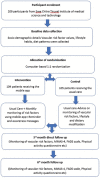Medication-Adherence and Management of Risk Factors for Secondary Prevention of Stroke Using Smartphone-Based Application: Protocol for MAMORs-Randomized Controlled Trial
- PMID: 36911480
- PMCID: PMC9996505
- DOI: 10.4103/aian.aian_836_22
Medication-Adherence and Management of Risk Factors for Secondary Prevention of Stroke Using Smartphone-Based Application: Protocol for MAMORs-Randomized Controlled Trial
Abstract
Background: In LMICs, the medication adherence and risk factor control are suboptimal in the post-stroke follow-up period. With shortage of physicians, smartphone-based interventions can help stroke survivors in secondary stroke prevention.
Objectives: We aim to validate a digital innovative technology-based intervention to improve the awareness, medication adherence, control of risk factors through timely intervention of physician among the stroke survivors.
Methods: MAMOR is a smartphone-based application to improve the stroke awareness by heath education materials, reminders to timely adherence of medication, alerts on control of risk factors, video files, and timely physician intervention. The study will involve development of the app using contextual research (Delphi qualitative method) followed by a randomized, single center, double arm-controlled trial with 1:1 assignment. The app will be evaluated over a period of 6 months with a target to enroll 192 participants. Process evaluation will be conducted. The sample size was calculated as 192, considering medication adherence of 43.8%, 20% increase in medication adherence by app, power of 80%, and 10% loss to follow-up.
Results: The primary outcome will be medication adherence, changes in the lifestyle and behavioral and control of vascular risk factors. The secondary outcome will include vascular events and functional outcome.
Conclusion: This study will be one among the few studies for secondary prevention of stroke through digital technology innovation in LMICs with resource constraints. The evidences generated from this study will provide translational evidence for other similar settings for stroke survivors.
Keywords: Medication adherence; risk factors; secondary prevention; stroke.
Copyright: © 2022 Annals of Indian Academy of Neurology.
Conflict of interest statement
There are no conflicts of interest.
Figures
References
-
- Shani SD, Varma RP, Sarma PS, Sylaja PN, Kutty VR. Life style and behavioural factors are associated with stroke recurrence among survivors of first episode of stroke: A case control study. J Stroke Cerebrovasc Dis. 2021;30:10560–6. - PubMed
-
- Shani SD, Sylaja PN, Sankara Sarma P, Raman Kutty V. Facilitators and barriers to medication adherence among stroke survivors in India. J Clin Neurosci. 2021;88:185–90. - PubMed
-
- Sylaja PN, Singh G, Sivasambath S, Arun K, Jeemon P, Antony R, et al. Secondary prevention of stroke by a primary health care approach: An open-label cluster randomised trial. J Clin Neurosci. 2021;84:53–9. - PubMed


